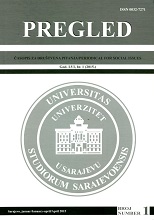STEREOTIPI I OGRANIČENJA U GLEDIŠTIMA NA PRIRODU I KARAKTER POZICIONIRANJA JAVNIH UNIVERZITETA U DRUŠTVU
STEREOTYPES AND LIMITATIONS IN ATTITUDES TOWARDS THE NATURE AND CHARACTER OF POSITIONING PUBLIC UNIVERSITIES IN SOCIETY
Author(s): Salih FočoSubject(s): Education
Published by: Univerzitet u Sarajevu
Keywords: university; education; society; institutions; policy; system; power; man; needs; interests; tolerance; school
Summary/Abstract: Countries that conceive their development on knowledge and education are facing the positioning of public universities in the social reality or transitional change. In our context, we can define university as a socially responsible and developed structure that is being based the on traditional, economic, cultural and political basis of society. The transition and positioning of public universities in the market and competitive conditions is a complex issue certainly unable to provide the unilateral answer. It is about a process that is conforming to the value system other than political points of view. Namely, the education and science are universal categories measured in global terms, and not at the local level. Precisely due to their peculiarity, certain stereotypes about the university, higher education, as well as its public positioning are either present or rooted. Those stereotypes could be ranked into traditional, modern and postmodern common denominators. Taking into consideration the University of Sarajevo’s strength and capacity in scientific and educational terms, it would be practical to consider enacting a specific law on the University of Sarajevo and its positioning as the strategic factor of country’s development as a whole and its tasks in the social, economic and technological transformation of Bosnian society. In this way, the state would receive a powerful generator of designed changes and the carrier of the idea of progress and social development, whilst the University of Sarajevo would be in the place that belongs to it.
Journal: PREGLED - časopis za društvena pitanja
- Issue Year: LVI/2015
- Issue No: 1
- Page Range: 51-58
- Page Count: 8

